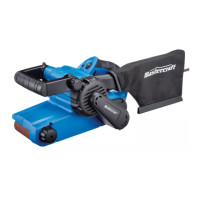12
OPERATING INSTRUCTIONS
TURNING THE SANDER ON AND OFF
The tool can be turned “ON” or “OFF” by squeezing or releasing the trigger.
“LOCK-ON” BUTTON
1. The tool is also equipped with a “Lock-ON” button that allows continuous operation without
continually holding the trigger.
2. To lock switch “ON”: Squeeze trigger, depress the “Lock-ON” button, and release trigger.
3. To unlock switch: Squeeze trigger, then release trigger without depressing the “Lock-ON” button.
GENERAL SANDING
1. Be sure the cord is clear of the belt. Grasp the handles firmly.
2. Start the sander off of the work surface to avoid gouging the belt. NEVER start or stop the sander
with the belt in contact with the work surface.
3. Place the heel of the sander on the work surface first. Then, with a forward motion, begin the
sanding stroke as the tool is lowered onto the work surface.
4. Use short, overlapping strokes, moving the sander slowly back and forth across the work surface.
5. Avoid tilting or rocking the sander or sanding in one spot for too long. This causes gashes and
hollows in the surface. Do not apply pressure to the sander. The sander is the weighted for the
pressure needed. Too much pressure will overload the motor and reduce the belt speed.
6. Begin sanding with a coarser grit sandpaper and gradually use finer grits, until the desired finish is
achieved. Do not switch from a coarse grit to a very fine grit in one step.
7. To stop, lift the sander from the work surface, then turn the sander OFF. Disengage the Lock-ON
button. Allow the sander to come to a complete stop before setting it down. A moving belt will cause
the sander to “run away” even if the motor is off.
OPERATING INSTRUCTIONS
WARNING!
• Before sanding small workpieces, ensure workpiece is securely held in a vise or clamp.
• Sanding can produce clouds of fine dust particles that can ignite in the presence of sparks or an open flame. To avoid injury,
always use your sander in a well-ventilated area.
• For your safety and to avoid damage, turn the sander ON and OFF only when the sander is not in contact with a surface.

